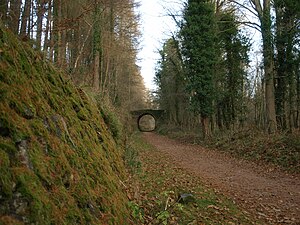 A section of the Severn and Wye Railway, now in use as a cycle and footpath. | |
| Overview | |
|---|---|
| Locale | West Gloucestershire |
| Dates of operation | 1810–1977 |
| Technical | |
| Track gauge | 4 ft 8+1⁄2 in (1,435 mm) standard gauge from 1872 |
| Previous gauge | 3 ft 6 in (1,067 mm) from 1810 to 1868 7 ft 1⁄4 in (2,140 mm) from 1868 to 1872 |
The Severn and Wye Railway began as an early tramroad network established in the Forest of Dean to facilitate the carriage of minerals to watercourses for onward conveyance. It was based on Lydney, where a small harbour was constructed, and opened its line to Parkend in 1810. It was progressively extended northwards, and a second line, the Mineral Loop was opened to connect newly opened mineral workings.
To facilitate transfer of traffic to the neighbouring South Wales Railway main line, the Severn and Wye Railway network was converted from a plateway to a locomotive-worked broad gauge edge railway, and then to a standard gauge railway. Extensions were made to Lydbrook, Cinderford and Coleford.
The company's finances were dependent on the mineral industry of the Forest of Dean, and in 1879 economic difficulties caused it to amalgamate with the Severn Bridge Railway. In fact this resulted in a worsening of the situation, and the combined company sold its business to the Great Western Railway and the Midland Railway jointly.
Further disappointing financial performance led to most of the passenger operation being discontinued in 1929, and after World War II inexorable decline in mineral extraction resulted in progressive closure of the network. None of the Severn and Wye Railway system is in commercial railway use today, but a heritage railway is active at Lydney.